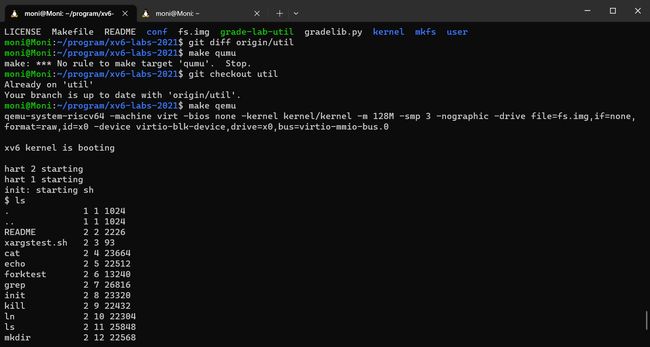MIT6.s081 Lab1 Xv6 and Unix utilities
Lab1的实现过程,该实验主要是安装和运行,一个熟悉的过程, 并无特别,照着实验手册做就行了 ^ __ ^
实验手册
0. debug
分屏开窗口,两个shell都应该在xv6目录里操作;
# 左边窗口 make qemu-gdb #右边窗口 gdb-multiarch #在gbd页面内 target remote localhost:26000 # 非常重要,绑定端口! file user/_ls b main # break的缩写,打断点 c # continue的缩写
运行截图如下
1. Boot xv6
安装,没啥好说的,顺便提了一下git的使用,快速过掉。
# 前置 sudo apt-get install git build-essential gdb-multiarch qemu-system-misc gcc-riscv64-linux-gnu binutils-riscv64-linux-gnu # 克隆仓库 git clone git://g.csail.mit.edu/xv6-labs-2021 # 编译运行 cd xv6-labs-2021 git checkout util make qemu
运行截图
2. sleep
实验要求
Implement the UNIX program
sleepfor xv6; yoursleepshould pause for a user-specified number of ticks. A tick is a notion of time defined by the xv6 kernel, namely the time between two interrupts from the timer chip. Your solution should be in the fileuser/sleep.c.
简单来讲就是实现一个睡眠的程序,需要自己写在 user/sleep.c 里,一定要读一读实验手册里的hints,非常有用并且涉及到一些细节问题!
吸收之前项目的教训,我决定从代码主体结构开始构思,构思好以后再动手写,细节问题可以慢慢调试,但代码的主体结构如果出问题要更改就非常麻烦了。
代码框架
int main(int argc, char * argv[])
{
// 首先检测输入参数是否合理
if ()
{
}
// 如果合理,先转换成int,然后开始调用sleep
// printf("sleep %d ticks.\n", t0);
// 退出
exit(0);
}
细节
-
考虑输入为空或其他
-
将字符串转换为int类型
-
头文件的引用
实验结果
截图如下:
3. pingpong
实验要求
Write a program that uses UNIX system calls to ''ping-pong'' a byte between two processes over a pair of pipes, one for each direction. The parent should send a byte to the child; the child should print "
: received ping", where is its process ID, write the byte on the pipe to the parent, and exit; the parent should read the byte from the child, print " : received pong", and exit. Your solution should be in the file user/pingpong.c.
大义就是:用两个管道接收父子进程的数据,父进程发送一个byte,然后子进程接收后打印,然后子进程发送父进程一个byte,最后父进程打印输出。
代码框架
#include "kernel/types.h"
#include "kernel/stat.h"
#include "user/user.h"
#define W 1 // 读
#define R 0 // 写
int main()
{
// 创建两个管道
// fork
int pid = fork();
char buf[64];
// 分情况,父子进程
if (pid == -1)
{
fprintf(2, "fork filed.\n");
exit(-1);
}
else if (pid == 0) // 子进程接收然后打印ping
{
}
else // 父进程接收然后打印
{
}
// 退出
exit(0);
}
细节
-
p[1]是写端,p[0]是读端,建议使用后关闭,可以定义宏来方便理解。
-
检测程序是按照字符串判断的,一开始字符串不能出错(尤其是“ : ”前面没有空格,非常坑,调了半天发现是这个问题……太难受了)
实验结果
4. prime
实验要求
Write a concurrent version of prime sieve using pipes. This idea is due to Doug McIlroy, inventor of Unix pipes. The picture halfway down this page and the surrounding text explain how to do it. Your solution should be in the file
user/primes.c.
用管道编写一个筛选质数的筛选器,可以参考超链接和下图:
目标是使用pipe和fork来设置管道。第一个进程将数字2到35输入到管道中。对于每个素数,您将安排创建一个进程,该进程通过一个管道从左边的邻居读取数据,并通过另一个管道向右边的邻居写入数据。由于 xv6的文件描述符和进程数量有限,因此第一个进程可以停留在35个。
思路
因为稍微有一点复杂,建议理一理思路后再动手。
每次将符合要求的全部传入管道中,第一个传的一定是素数,直接打印,然后将其他符合要求的再次传入管道并传给子进程。我自己的方法是递归处理,并没有完全利用到多进程的性能,如果有改进的办法,可以提出来讨论一下。
一开始想的是循环,但是循环就比较烧脑,因为子进程还会创建子进程,非常痛苦,最后选择递归。
总的来说实现比较让人难受,想了挺久的,最后还是参考了别人的思路。
代码框架
// 示例伪代码如下 p = get a number from left neighbor print p loop: n = get a number from left neighbor if (p does not divide n) send n to right neighbor
void pipe_prime(const int *p)
{
// 传入并输出素数。
while((read(p[READ_P], &num, 4)) != 0)
{
}
// 递归调用该函数
// 等待子进程结束,很重要
}
int main()
{
int p[2];
pipe(p);
// 先全部传,然后在函数中处理
for (int i = 2; i <= 35; ++i)
{
write(p[WRITE_P], &i, 4);
}
close(p[WRITE_P]);
pipe_prime(p);
close(p[READ_P]);
exit(0);
}
细节
-
需要关闭管道的文件描述符以免资源耗尽;
-
fork函数返回两个值:父进程返回子进程的pid,子进程返回0;
-
需要等待子进程结束,否则结果可能不全。
实验结果
5. find
实验要求
Write a simple version of the UNIX find program: find all the files in a directory tree with a specific name. Your solution should be in the file
user/find.c.
写一个在目录树中查找含有特定名字的程序;
思路
-
输入字符串(可能有多个);
-
递归获取所有的文件名(包括目录);
-
找出匹配的文件名;
-
打印;
代码框架
#include "kernel/types.h"
#include "kernel/stat.h"
#include "user/user.h"
#include "kernel/fs.h"
int find(char * dir, char * path)
{
// 参考ls定义变量和结构体,注意该函数我加了最后是否查找成功的功能,所以需要一个变量来判断。
if ((fd = open(dir, 0)) < 0)
{
fprintf(2, "find: cannot open %s\n", dir);
return -1;
}
if(fstat(fd, &st) < 0){
fprintf(2, "find: cannot stat %s\n", path);
close(fd);
return -1;
}
strcpy(buf, dir);
p = buf + strlen(buf);
*p++ = '/';
while((read(fd, &de, sizeof(de))) == sizeof(de))
{
// 判断文件状态,普通文件就直接比较字符串,文件夹直接递归调用即可。
}
return findSuccess;
}
int main(int argc, char* argv[])
{
if (argc < 2 || argc > 3)
{
fprintf(2, "Usage: find ...");
exit(0);
}
int flag;
if (argc == 2)
{
flag = find(".", argv[1]);
}
else flag = find(argv[1], argv[2]);
if (flag != 1)
{
fprintf(2, "find error.\n");
exit(-1);
}
exit(0);
}
细节
-
跳过de.inum == 0 和 de.name == "." 以及 de.name == ".."(使用strcmp来进行字符串的判断);
-
只能使用user.h中的函数,我妄图使用strcat,但是发现并没有, 其实也不需要strcat;
-
查找目录最好还是递归调用。
实验结果
总体来说不是很难,但是很多步骤需要参考ls.c,所以有些繁琐,慢慢理一理还是能理清楚的。
6. xargs
实验要求
Write a simple version of the UNIX xargs program: read lines from the standard input and run a command for each line, supplying the line as arguments to the command. Your solution should be in the file
user/xargs.c.
编写一个简单版本的 UNIX xargs 程序: 从标准输入中读取行,并为每一行运行一个命令,将该行作为参数提供给命令。您的解决方案应该在 user/xargs.c 文件中。
思路
没什么头绪,我也借鉴了别人的思路,过后想起来,觉得自己之前没懂的地方就是如何从管道中读取到来的参数,其实直接read(0,buf,sizeof buf)就可以了, 因为管道相当于走的标准输入流。
-
首先创建字符串数组存放行参数,可以用index来表示执行的顺序;
-
从管道中循环读取参数,遇到换行符,就直接跳过;
-
子进程执行,父进程等待。
代码框架
#include "kernel/types.h"
#include "kernel/stat.h"
#include "kernel/param.h"
#include "user/user.h"
const int MAXN = 512;
int main(int argc, char *argv[])
{
if (argc < 2)
{
fprintf(2, "Useage: xargs ...");
exit(-1);
}
int i, n;
char* args[MAXARG];
char buf[MAXN], buf_child[MAXN/2];
char *p1;
char *p2;
// 读取到args中,方便后续执行,注意这里的i是整个程序通用的变量,并不是局部变量;
for (i = 0; i < argc - 1; ++i)
{
}
p1 = buf; // 指向buf的头部
while ((n = read(0, p1, MAXN)) > 0)
{
// read已经对buf填充了,这里是在调整指针的位置,防止覆盖
}
p1 = buf; // 再次指向头部
// 循环查找\n,直到字符串的结尾
while ((p2 = strchr(p1, '\n')) != (char *)0)
{
*p2 = 0; // 替换为字符串的结束符
if (fork() == 0)
{
// 子进程的p1并不影响父进程,所以可以随意修改p1而不影响主程序
memmove(buf_child, p1, strlen(p1));
p1 = buf_child;
while((p2 = strchr(p1, ' ')) != (char*) 0)
{
// 以空格为分隔符,来分割字符串,strlen在找到0(字符串结束符)时会停止计算
// 调整到空格的下一位,然后重新开启循环
}
// 最后一个空格,循环无法处理,所以到外面处理
exec(argv[1], args);
exit(0);
}
else
{
p1 = p2 + 1; // 父进程仅仅是读取字符串,交给子进程处理,所以这里需要跳到下一个字符串的位置
wait(0);
}
}
exit(0);
}
细节
-
可能需要修改find(),以达到作为文件使用的目的(./a这种形式);
-
三个缓冲区, 每个都有不同的意义;
-
i非常奇妙,专门将其
main函数范围内的局部变量,生命周期和main函数一致而非for循环; -
父进程一定要wait;
-
两个指针,交替使用,来达到分割字符串的目的。
实验结果
总的来说是一个比较综合性的实验,几乎结合了前面的所有知识点, 也复习了很多知识点,收获良多,但其中有一些关于pipe的操作还不太熟练,比如0就是管道默认输入流,以及对空间分配的使用,在使用memmove之前,一定要先分配空间;对于字符串也有一定收获,因为字符串的结尾可以用0表示,此时字符串指针如果需要使用strlen之类的,就会在0时停止,打印和使用指针也是,在遇到0之后就会停止。
Grade
后续的other实验感觉有些挺有意思的,有时间的话做来看看, 但现在忙着准备期末复习,所以就先鸽了。
综合检测结果如下:
需要在文件目录下的命令行中输入 make grade ,注意:需要创建一个time.txt,内容就是你完成的小时数(一个数字即可,单位默认为小时);
Other
挑战项目:后续有点想做sh的自动补全和上键显示之前的代码,不然和linux的shell用起来感觉不一样,不太方便。
后面有机会一定更新!(可能也许大概不鸽)








